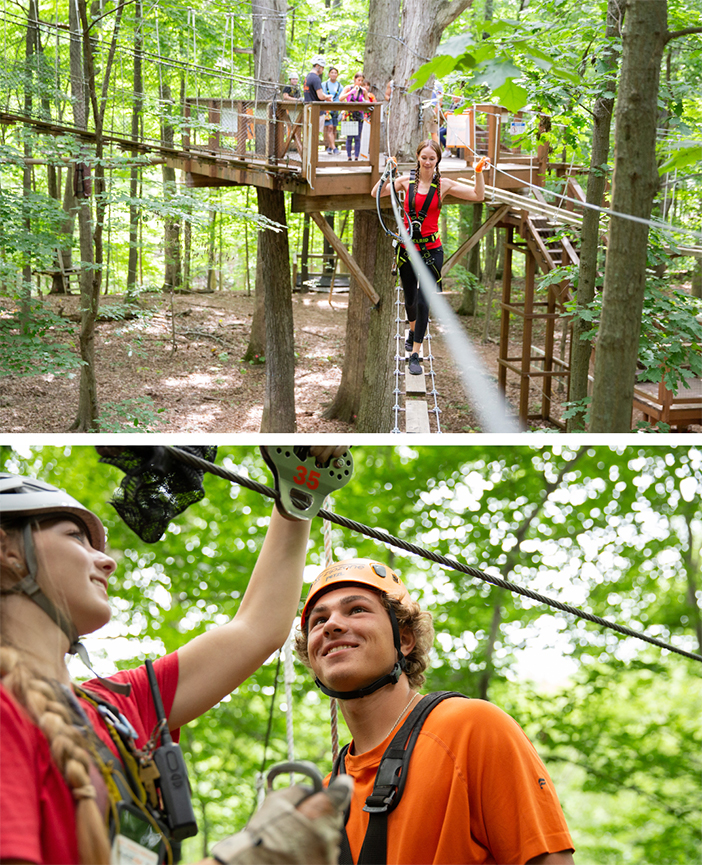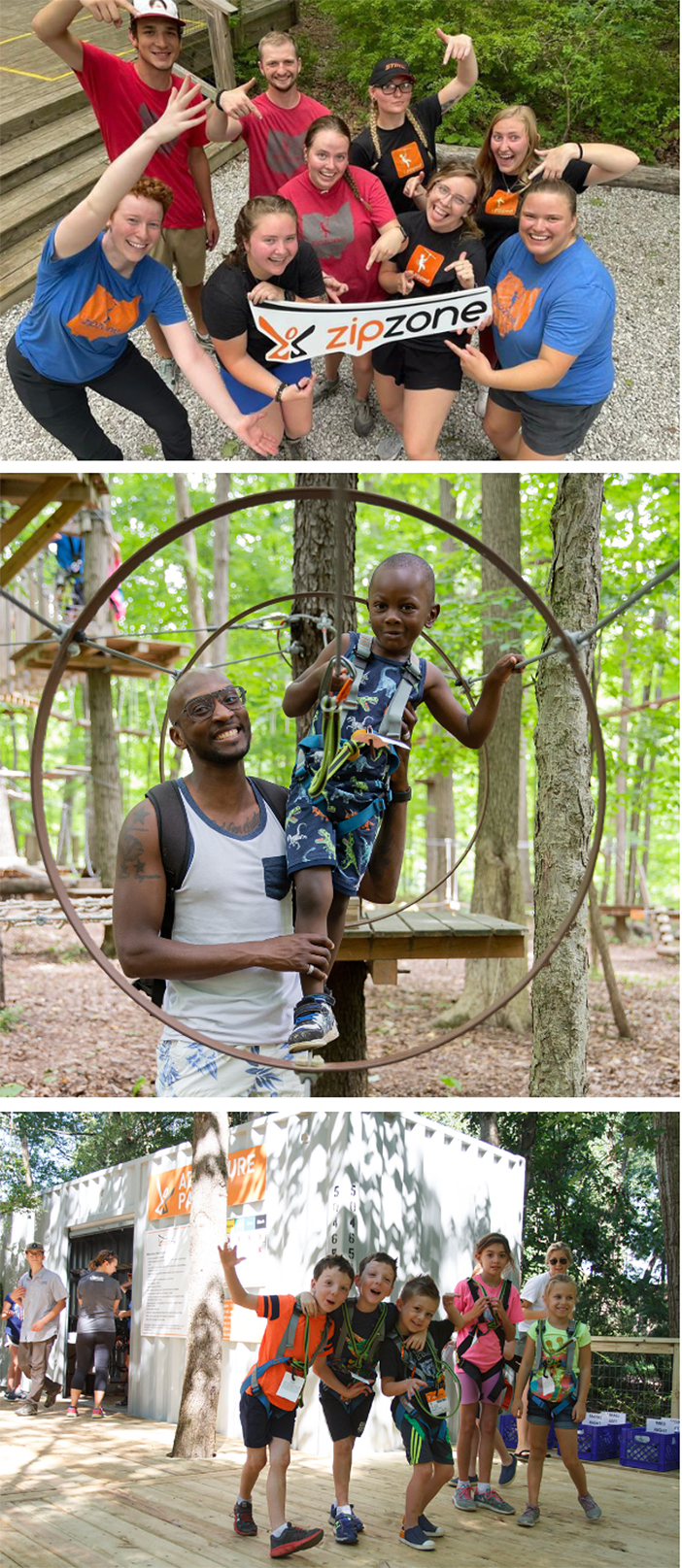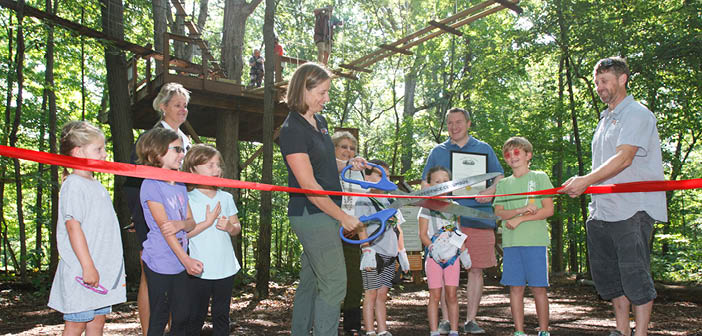When the nascent North American adventure park industry began gaining momentum in the early 2000s, Jerrod and Lori Pingle were natural candidates to jump into the action. With previous experience in camp management, facilitating, and ropes course design, they had already begun honing a skill set that would fit well within the framework of adventure park design, construction, and logistics.

ZipZone’s Lori and Jerrod Pingle.
In 2004, they formed Get a Grip Adventures to build climbing walls in school gyms. In 2010, they grew Get a Grip into a consulting business focused on zip line tour trainings, inspection, consulting, and equipment sales. (The Pingles ran Get a Grip until 2018, when they merged it with another company.) From that experience, they built a wealth of zip tour knowledge. “We got to design and deliver trainings for a lot of different operating systems,” says Lori, “which helped us learn about what created the best guides.”
At about the same time, the Pingles began looking for a place to build their own zip tour. They scouted for a location “anywhere in the Midwest,” says Lori.
They liked what they saw at Camp Mary Orton, a nonprofit summer camp and events facility in Columbus, Ohio. They worked out an arrangement with the camp management to build ZipZone Outdoor Adventures on a portion of the camp’s 167-acre lot. While the camp and the tour would operate independently, the two entities were likely to dovetail comfortably. As Lori says, the tour would be “a natural offshoot of what they [the camp]do.” (In fact, the camp and ZipZone currently collaborate on their summer-camp program.)
THE MAKING OF ZIPZONE
Before construction began, however, and before the Pingles tried to sell the idea to potential investors, they wanted to be sure that there would be at least a reasonable chance for success.
Feasibility. Columbus, after all, wasn’t a major tourist destination, so they couldn’t count on vacationing travelers to generate a big chunk of revenue. In addition, says Lori, Columbus “was not an outdoor-recreation capital,” so a burst of local interest in a zip tour was not likely. Reaching and attracting an appropriate audience, whether local, regional, or more far-flung, would take a well-focused business plan.
Toward that end, the Pingles hired the consulting firm, Strategic Adventures, to generate a feasibility study and business plan. The study, says Lori, would be “a key to getting investors interested.” This was the first in a series of decisions the Pingles made to seek out expert help and advice rather than rely exclusively on their own experience, expertise, and business sense.
With the feasibility study providing the basis for a workable game plan moving forward, investors were secured and construction of an initial zip line canopy tour began in 2012.
Design and construction. Yet even though their consulting business and zip tour experience had provided a wealth of knowledge, they turned to outside help for the initial design and construction. With Get a Grip, “Zip lines were our focus, our wheelhouse,” says Lori. When it came to building their own tour, “We had the expertise, but not the crew,” she adds. “We hired a company who had the crew to do the labor and build it. We worked with the lead builder on the design and layout of the course.”
The team they chose was led by Jason Lindsey, who had experience with well regarded zip line builder CLIMB Works. While Lindsey’s team spearheaded the construction process, Jerrod “weighed in on design and planning,” says Lori. The result was a five-zip tour, connected by four suspension bridges.
Pricing strategy. When the tour opened in 2012, the Pingles established a pricing strategy based on two-hour sessions, according to “what similar things in the region cost,” says Lori. That was no easy task. There were only a few comparable activities (a water park and a trampoline park) in the area, and a few zip tours elsewhere in the state, so determining what to charge wasn’t clear-cut. Pricing was based on expenses plus a reasonable profit margin.
BUILDING AN AUDIENCE
What followed was a test of patience. Given the inherent challenges in the Columbus market—relatively little tourism and a general lack of outdoor-recreation enthusiasm in the local population—”business was a little slower at first than we thought it was going to be,” says Lori. It took about three years for revenues to ramp up to a respectable flow rate.
The Pingles also realized their potential audience needed to be approached differently than what they had come to know through Get a Grip, where team building was a major objective. For a zip line tour, the primary focus shifted to getting newcomers excited about engaging in an aerial adventure activity simply for the thrill of it. Team building might be involved at times, but it was secondary.
How, then, to connect with that audience? Once again, the Pingles sought outside advice, enlisting the help of marketing consultants to guide them on where to look for potential customers and how to attract them. One strategy they employed was to work in tandem with regional convention and visitors’ bureaus, stretching out their marketing net to reach customers in potential day-trip communities such as Detroit, Pittsburgh, and Indianapolis, all within a three-hour drive.
Filling gaps. After the success of the initial business had become established, the Pingles contemplated next steps. “Where are the gaps?” was the question they asked themselves, says Lori. In other words, what segments of the potential market was the ZipZone zip tour unable to satisfy?
In 2014, they added a once-a-month night tour to the experience menu, adding a nugget of uniqueness that might plug a gap in ZipZone’s overall offerings.
Over the years, the Pingles further filled tours by adding special event programs. Among these: Forest Discovery Tours, led by a naturalist from the local Metroparks; Birding Tours, led by a pro birder; and Flight Club, a partnership with the Ohio Falconry Association that combined an experience at ZipZone with a class on how to work with birds of prey.
GROWTH THROUGH EXPANSION
They also hit on two market segments that they might be missing: large groups—perhaps 75 strong or more—and families with small children. Because the zip tour was limited to participants age 7 and older, any family with younger kids would have to be turned away. And because ZipZone has to space out groups—and limit group sizes to eight per tour—the opportunity to accommodate a large group efficiently was severely constricted.
To resolve the second problem, in 2017 the Pingles added an adventure park—five connected, elevated ropes courses with 60 elements (including zip lines) of varying degrees of difficulty, with course difficulties color-coded. “Adventure parks have a higher throughput,” notes Lori.

Top to bottom: Navigating one of 60 elements on the ropes courses; clipping in for the five-line zip tour.
The Pingles chose to go with a smart belay system—LockD—rather than a continuous belay, as the smart belay allowed for some guest interaction with the system, which the Pingles liked. “We felt like it was good fit for our business to have our experience be more interactive instead of being clipped in and go,” says Lori.
To address the lack of small-kid activities, a low ropes course was added to the mix, with features simulating the main park, for kids aged 4 through 7. The park was designed so parents can walk along with their kids as they navigate the course, at no additional fee.

Top to bottom: Staff smile with the ZipZone logo; a parent accompanies their child on the low ropes course; participants gather outside the gear room.
For the new courses, the Pingles hired Dave Horan and Horan Adventure Development to do most of the work. This time, says Lori, the Pingles “took more of a backseat” in the design and construction process, since they had less experience in these sorts of projects than they did in developing zip line courses.
Not that the Pingles had no experience with ropes courses. Jerrod started in the industry as a ropes course builder in 1996 with Direct Instructional Support Systems, an ACCT PVM, and later worked for a PVM building large scale zip line tours in Hawaii. He also worked as a ropes course and team building facilitator and trainer. Lori worked for the same companies in different roles.
SEASONAL CHALLENGES
ZipZone operates seasonally, from April into November, and one of the biggest challenges of dealing with a four-month closure is retaining staff over the hiatus. In addition to Lori and Jerrod, ZipZone employs three full-time staff members to cover a variety of tasks, from operational management to training and course maintenance. But the meat of the staffing challenge—where most of the turnover is—is in the 50 part-time, seasonal staffers (guides, etc.) that keep daily operations humming.
The staff retention factor changed noticeably as a result of Covid, says Lori. When Covid forced closures, “we lost the vast majority of our staff,” she says, causing a need to start virtually from scratch when things reopened.
Before the pandemic, ZipZone was able to sustain a high return rate from one year to the next—about 70 percent. Since then, that percentage has dropped closer to 40 to 50 percent, with shoulder seasons (spring and fall) presenting the biggest staffing challenges.
Easing staffing challenges. Learning from their many years of experience in guide training, the Pingles have emphasized the importance of creating “a sense of pride in their work,” and in finding an appropriate balance between attention to safety and having fun on the job.
“We make it fun with staff challenges, things like who can pull themselves up all of the zip lines on the tour, or how fast can you navigate a certain adventure park course,” says Pingle. “We also have staff outings throughout the summer, like pool parties, staff night climbs on the adventure park, or camp outs.”
To further ease the workload, ZipZone is open just six days a week, giving one day a week for staff to rest and recharge and for full-time staff to see to regular maintenance. “It really helps in making the week go better,” says Lori.
Another way in which ZipZone has been able to address staffing challenges has been to keep food and beverage offerings simple. The park offers just drinks and snacks, says Lori, rather than a full-service kitchen and restaurant, which would require more staff.
LESSONS TO LEARN
Lessons to be learned from what the Pingles have done at ZipZone? First, start with what you know best—in the Pingles’ case, zip lining—then develop a well-focused business plan, with a realistic assessment of the possibilities of success, before breaking ground.
Second—don’t think you know it all, despite what previous experience might tell you. Be willing to seek outside expertise in various aspects of the business: design, construction, marketing, etc.
Third, before expanding, be patient to make sure the business has indeed achieved profitability, and have a clear idea of the gaps that any new addition might fill.
Finally, don’t bite off more than you can chew. For the time being, the Pingles have no plans for further ZipZone expansion or for developing any other parks or projects elsewhere. With a young family that has added the responsibilities of parenthood to the mix, they don’t want to overextend themselves. Their current operation is running smoothly and successfully, so why mess with a good thing?






